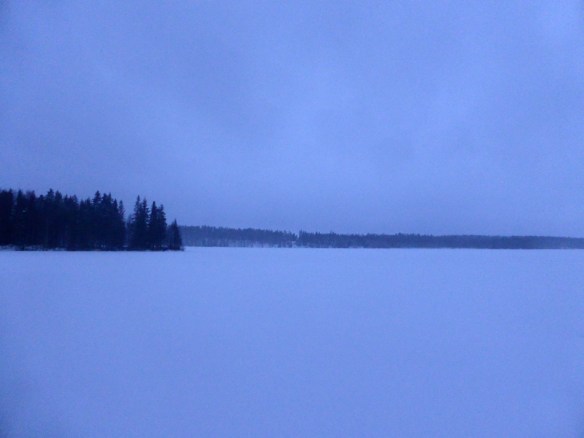by Brendan Howe
Contemporary orchestral composer extraordinaire Kalevi Aho gives us an abstract, impressionistic version of the extremes of Lapland – the far northern region of his native Finland – in a dual release of his Horn Concerto and Theremin Concerto. The concertos feature soloists Annu Salminen and Carolina Eyck, respectively.

Throughout the single-movement Horn Concerto, Aho added what he describes as a ‘ritualistic’ element, wherein the soloist opens the piece backstage, then moves gradually across the stage from left to right before going backstage again towards the end.
 Beginning with spare details from Annu Salminen’s French horn, the concerto moves forward to reveal a discordant undercurrent of energy that continues throughout both pieces. Strings pierce like icy wind over the gray landscape, horns call to one another in pine forests, and clarinets and oboes hurry from their front doors to their cars and hope the frost hasn’t yet set in their engines. There are occasional moments of respite and silent wonder in this dreamlike hallucination. The piece has a structural and stylistic integrity that makes it at once recognizable and unpredictable – a unique and intriguing combination.
Beginning with spare details from Annu Salminen’s French horn, the concerto moves forward to reveal a discordant undercurrent of energy that continues throughout both pieces. Strings pierce like icy wind over the gray landscape, horns call to one another in pine forests, and clarinets and oboes hurry from their front doors to their cars and hope the frost hasn’t yet set in their engines. There are occasional moments of respite and silent wonder in this dreamlike hallucination. The piece has a structural and stylistic integrity that makes it at once recognizable and unpredictable – a unique and intriguing combination.
Before smoothly segueing into the Theremin Concerto as Aho does, here are some brief notes on the unusual device. As the world’s first electronic instrument, it has accrued an extremely limited canon since its debut 96 years ago, due to its otherworldly, hair-prickling tone. For perspective, 1950s sci-fi movie soundtracks and the Beach Boys’ Good Vibrations comprise its best-known works.
 Carolina Eyck is one of few extremely talented thereminists in the world. When Aho saw her perform, he was fascinated by the way that the instrument is played, merely by moving and manipulating one’s hands within the electromagnetic field of its two antennae. This inherent theatrical element, combined with Eyck’s flair for performance, inspired him to write the Theremin Concerto specifically for her.
Carolina Eyck is one of few extremely talented thereminists in the world. When Aho saw her perform, he was fascinated by the way that the instrument is played, merely by moving and manipulating one’s hands within the electromagnetic field of its two antennae. This inherent theatrical element, combined with Eyck’s flair for performance, inspired him to write the Theremin Concerto specifically for her.
The concerto is organized into eight continuous movements, based on the traditional eight-season division of the year of Lapland’s native Sami people. It is telling (though unsurprising) to note that the titles of five of the eight movements involve or imply some form of snow or frost.
Ernte, or Harvest, opens the work, seemingly just after all the festivities have ended and the coming winter looms large in mind. The controlled wail of the theremin complements the orchestra—for now.
The second and third movements, entitled Herbstverfarbung (Autumn Colors) and Schwarzerschnee (Black Snow) make use of the vocal capacities of both clarinet and theremin, each calling their kin to come home as the daylight wanes ever more quickly. Aho expertly evokes the micro-events occurring within the season in preparation for the long darkness, and adds a faint, percussive texture of dead brambles as the work moves into Weihnachtsdunkelheit (Christmas Darkness). Tinkling triangles chime every so often, revealing a mystical spirit in the otherwise bleak scene.
The next movement, Frostwinter, holds nothing back, and the full, cold, spectral fury of the blizzard is unleashed. The listener is enveloped in a white-out world of high winds and ferocious frost, semitonal dissonance between the strings, horns, and woodwinds paint a sort of grayscale Munchian backdrop for the completely out-of-control theremin.
Once the storm is passed, a triangle cautiously pierces the snow-muffled landscape, and people peek out of their windows to see their first sunlight for weeks as the strings build upon a rare, major tonality.
Not being one to give the impression that all is well, Aho continues with the final three turbulent movements—Tragender Schnee (Crusted Snow), Eisschmelze (Melting of the Ice), and the final, longest movement, Mitternachtssonne (Midnight Sun)—tempering his work with the wisdom of those who live through cycles of extremes every year. He allows the listener to recognize that judgments of good and bad are irrelevant because the cycle is, by definition, a unified whole. Each instrument, especially the outlandish theremin, weaves its own path and, occasionally, helps another navigate the harsh seasonal shifts of Lapland.

